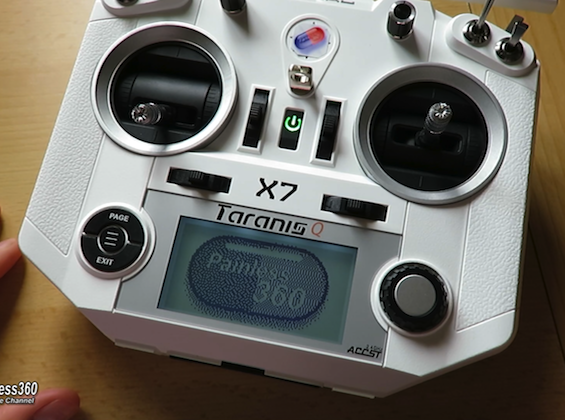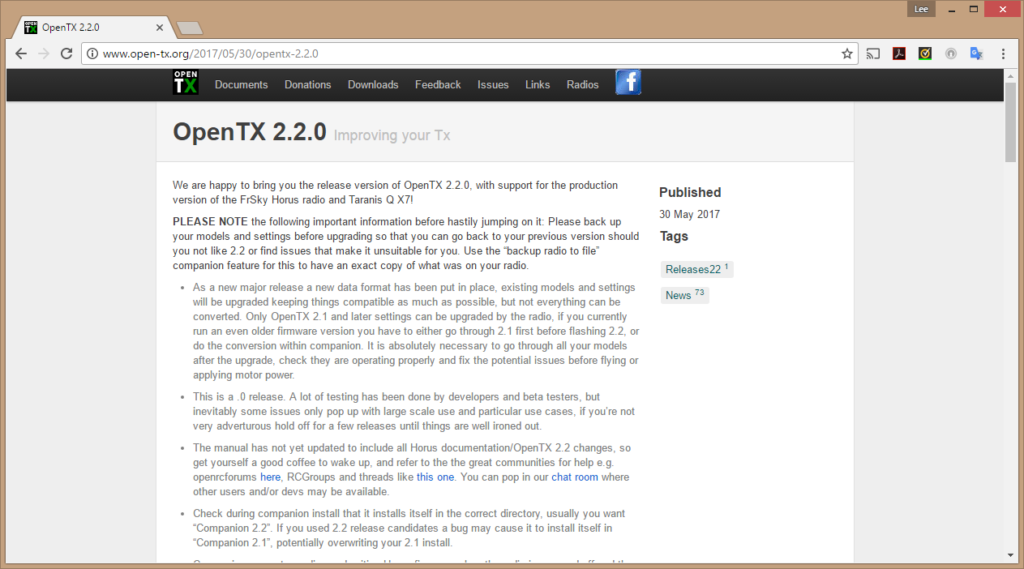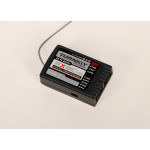
Written by Painless360
Introduction
OpenTX was finally released at the end of May. This was after many months spent working on the last of the bugs and additions to the software by the development team and testers. In this article, I’ll take a look at what’s new and why upgrading to OpenTX 2.2 may be for you.
What is the OpenTX Project?
The OpenTX project is an open-source project that develops the software and firmware that the FrSky and other radio transmitters use. Radios like the Taranis X9D/X9D+, Q X7, Horus, Turnigy 9XR, and 9X radios all run OpenTX firmware.
Combined with cost-effective hardware like the FrSky radios, OpenTX has quickly become the choice for many pilots and provides a very powerful radio system that can easily create everything from simple models to very complex setups for even the most demanding pilot.
Until the end of May, the previous release of OpenTX 2.1 was the latest and greatest with many pilots still happily running OpenTX 2.0.
The passion and ingenuity of the open-source developers make for a product that is very closely tied to the demands of the community. But, it’s not for everyone. I came to OpenTX from Spektrum radios and the way that OpenTX used inputs and mixes blew my mind at first, there seemed to be so many extra steps in setting up a model in OpenTX itself. But, it’s those very extra steps that provide such a powerful, flexible system to allow you to get the radio to do pretty much anything you want.
 OpenTX is free, download something called OpenTX Companion, configure the radio you want to flash and then select the options you need (even including a custom splash screen that the radio will show on start-up if you really want to!) and then OpenTX Companion downloads the latest firmware, configures it and flashes it to the radio. It then upgrades all of the models on the radio to work with the new version (you should test/check them all though, for safety).
OpenTX is free, download something called OpenTX Companion, configure the radio you want to flash and then select the options you need (even including a custom splash screen that the radio will show on start-up if you really want to!) and then OpenTX Companion downloads the latest firmware, configures it and flashes it to the radio. It then upgrades all of the models on the radio to work with the new version (you should test/check them all though, for safety).
The main change when OpenTX 2.1 was released was the new telemetry system. FrSky radios, powered by OpenTX have one of the best, least costly telemetry systems around. With OpenTX 2.1 the telemetry system was completely re-written and allowed pilots to not only see details from FrSky sensors like airspeed indicators, GPS units, and voltage and current sensors but to also receive data from flight controllers and other systems too.
Software like Betaflight, iNavflight, and Cleanflight all have support for FrSky telemetry built-in so with a couple of cables back to the Smart Port connections on the receiver you can get all of that back to the radio. Cool eh? So let’s look at what the team has added/changed in OpenTX 2.2.
So what’s new?
There are many changes and all can be found in the release notes and documentation of the project.
Reading the release notes can be an exercise in ‘reading between the lines’ as what the change is, and what the change will do for pilots are two different things.
The main headline for this release is the introduction of two-way telemetry. So what?
Well, telemetry had up till now been one way – the remote radio receiver in the model sends the telemetry data to the radio and then you can display this data on the screen and even set alarms for certain things (low voltage, battery almost empty, height, range warnings, etc.).
With two-way telemetry, we can send data to the receiver and have things change on the model in real-time. FrSky introduced two specialized radio receivers for use in fixed-wing models called the S6R and the S8R (more on that in a moment) that would act as a traditional FrSky receiver but also stabilize the model too. You can dynamically read and change the setting and make adjustments to the receiver as you fly using the radio so you don’t have to have a PC at the field anymore.
Another amazing use of this technology is the ability to change the settings on your UAV or Drone using the radio too. Imagine being able to tweak the PID settings on the model from the radio. Or, being able to change how the model is flying without the need for extra telemetry radios and ground-stations. You need to run LUA scripts (like apps for your radio) to use these new features. Exciting stuff indeed.
Support for the FrSky Taranis X7 and Horus
The FrSky Q X7 was released a few months ago with a pre-release version of OpenTX 2.2 installed. Now those of us who own the radio can install the final, released version and take advantage of all the improvements and fixes added to the code since the radio shipped.
The ability to emulate all of the radios supported has been added to OpenTX Companion 2.2 now as well so Horus and Q X7 users can explore settings and setups on their PC and use the interface to backup and configure models too.
Support for FrSky S6R receiver (configuration wizard on SD Card download)
In addition to the bi-directional telemetry that I’ve already talked about, these new receivers are now fully supported. The LUA scripts needed are included on the SD card itself, one for the calibration of the unit and one for the configuration so you can change the settings dynamically.
Until now these receivers have been tricky to use and setup and the release of the Beta software for these receivers appears to be working well with the release of OpenTX 2.2.
Other new stuff...
So in addition to these headlines, there are lots of extra things that have been included in the release. Some may be of more interest than others.
Support for Team Black Sheep Crossfire telemetry and updated protocols have been added. The Crossfire system allows for long-distance and the addition of the extra telemetry will be great for those pilots using the system.
The checking on the radio that versions are in sync with OpenTX has improved too. An example is that you will get a warning if the sound pack on the SD card is not the right version. It does this by checking the contents of a special file called opentx.sdcard.version in the root of the SD Card. The creation of custom sound files is still supported but as someone who’s had lots of pilots get stuck using the wrong versions of sound files, it’s a welcome addition.
See the documentation for everything that’s new. There are lots of cool little tweaks and improvements.
I’ve been watching the project on GitHub for the last two months as it came closer and closer to being ready for release. The majority of the things that needed fixing in recent weeks were for the Horus support and the extra tweaks in Companion to make it work reliably with all of the radios supported. I’m hoping that means that for Taranis X9D/X9D+ and Q X7 pilots this should be a solid release.
Tips for upgrading
Upgrading isn’t tricky and I found it easier than some other versions I’ve used. You do need to be running OpenTX 2.1 to upgrade though, the model memories are upgraded as part of the process and it’s expecting those to be in the OpenTX 2.1 format. There are ways to use the Companion to upgrade the memories to 2.1 from 2.0 but I’m not planning on covering it here.
Here are a few tips that should make the process go that little easier...
- Download and install Companion 2.2 in a different directory than Companion 2.1 to make sure you can still run both in case you need to. You can delete Companion 2.1 once you are happy everything is working great. When Companion installs, ignore the prompt to flash the radio immediately, there is some housekeeping to do first.
- Once you’ve got companion installed, connect to the radio, and before you do anything else, back up the EEPROM (where the models are stored) and the existing firmware on the radio to a file and save both into a safe place on your PC/Mac. Doing this should mean that you can go back to the start if something goes wrong or you don’t like it.
- Create a radio profile for your radio, choose the model you have, and give it a name you’ll remember. This option box is where you can set up how you want the base setting of the radio so take a minute to configure it all how you like it. Think about the options you want. I’d recommend checking the options shown in the image as a minimum, remember to check the EU box too if you’re flying in Europe. It will disable a few things like D8 mode though. (See documentation for full details). I’d strongly recommend making sure that ‘Append version number’ and ‘Offer to write firmware after download’ is selected.
- One of the nice features is the ability to add a flash screen on start-up. Each radio has a different screen size you will have to make an image for but it’s a fun touch to have the radio personalized to you. Be aware that the Q X7 cannot show greys so any image will be converted in an attempt to show the image.
- Once the settings are how you want them then connect the radio, put it into USB mode (usually by holding the horizontal trims to the center and powering on the radio), plug in the USB cable, and select flash firmware. Once the radio is working then before anything else, recalibrate the controls and sticks using the main menu.
- Finally, check existing models survived the upgrade ok. Don’t assume that they will all be intact. Here, I found that all of the model memories were great but on my Q X7 radio, I’ve not set up any of the more advanced models using things like logical switches, clever tricks with telemetry, LUA scripts, or special functions.
My experience so far...
Its early days for OpenTX 2.2 so the next few weeks will show how solid the version is. Normally, I’d wait until the 2.2.1 release or later before flashing any of the radios as a much larger community of pilots using the software will find things that the smaller group of testers didn’t come across. But, so far it’s been very good.
The lack of the ability on the Q X7 has caused a few interesting choices by the developers. On other radios, they use LUA scripts to act as a ‘Model Wizard’ to set up the basic controls for a ‘plane, quadcopter, flying wing, and helicopter. This LUA script is great and uses a lot of graphics to help you set up the model you need. Rather than work around this limitation on the Q X7 and replace the graphics with word prompts (as they did with the S6R calibration routine) they decided to remove it all together leaving those pilots with a Q X7 to have to manually set up models every time.
I have managed to get the S6R to talk to the radio with the new LUA scripts and the testing is looking very positive. This only works with the latest beta software for the S6R available to download from the FrSky main site. This looks to me like a few things changed in the final stages of development so I’ll not be surprised if we see a few more changes before all of that settles down. I suspect that this last bit of ‘settling’ will be seen in a few other areas too.
Upgrading took me all of 20 minutes, including shooing the footage for the how-to video. But I will be waiting for 2.2.1 (you can see it’s already underway with lots of new things coming in from the more widespread use of OpenTX 2.2) before flashing the main radios with the more complex model setups on them.
Summary
So would I recommend upgrading your radio now? Maybe. If you have an S6R or two in the spares bin then without OpenTX 2.2 it’s an expensive paperweight.
Without pilots downloading and using the technology then the issues will not be found. So my heartfelt thanks go out to the developers and testers who are helping grow this great software. If you don’t mind being on the leading edge and take into account all that comes with it. Go for it.
For me, I’ll hang onto 2.2.1 before upgrading another radio. Not because I don’t like what they’ve done but because I’m happy for the radios with 40+ models on, that are working well, to stay that way until I need to make the change.
My final thought on this goes back to those developers.
If you have a good idea or find a problem then let them know at the GitHub site. If enough pilots ask for a fix or feature (like a model setup wizard for the Q X7) then we have more chance of getting one!
If you use OpenTX and get enjoyment from it then do consider donating to the project. Remember we get all of this goodness for free. Let’s try and keep that the case.
Hear it First: Join our Mailing List
Sign up to receive new product updates, exclusive discounts, news, and more!












